
Responding to Online Reviews
Last updated on October 16th, 2025
Responding to both positive and negative reviews is part and parcel of reputation management, but did you know there are several business benefits to doing this?
It’s hard to get your brand personality or the personable face of your customer service team across on a review site, so a review response provides a vehicle to do just that. You can use this space to bring your own brand voice to the site, which helps you to create a more authentic engagement with that customer.
The impact of responding to reviews
Our latest consumer review research highlights the importance of responding to Google reviews, along with reviews on other platforms.
The Local Consumer Review Survey reveals that 96% of consumers read reviews for local businesses. Due to the design of many review platforms — including Google Reviews — each of those consumers could also have seen the business response to each of the reviews. This is valuable digital real estate that could be used to emphasize unique selling points (USPs), engage with consumers, and build closer relationships with those potential new and recurring customers or clients.
Seeing a response from a business owner also matters to local consumers, with whether or not a business responds to a review being an important factor for 46% of local consumers.
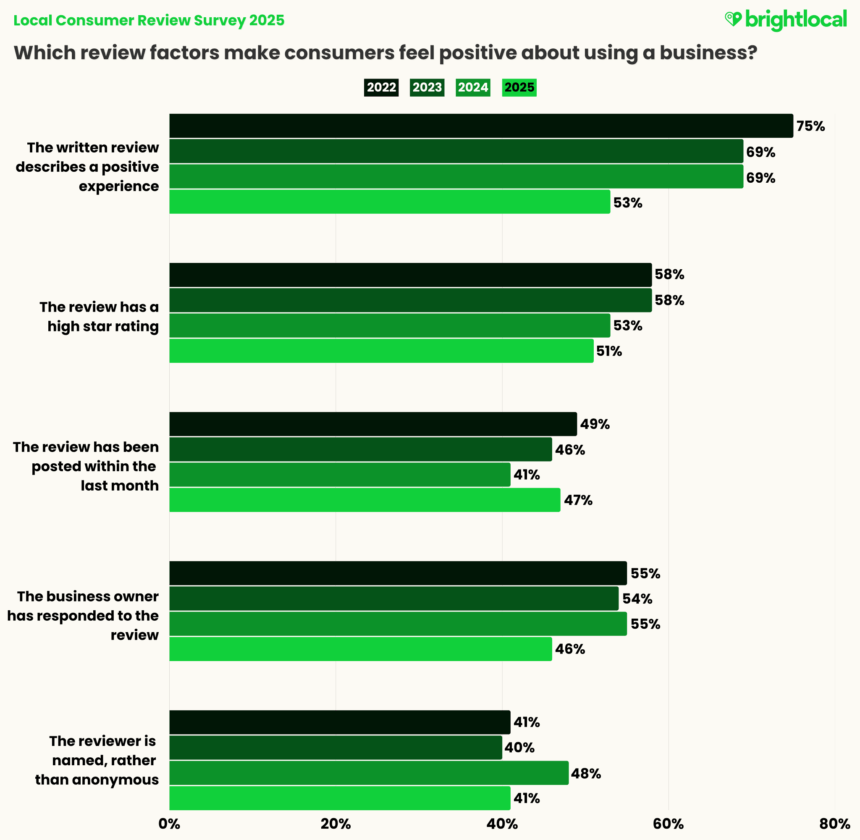
It’s clear from this data that consumers place a great deal of importance on businesses taking time to respond. This suggests that knowing how to respond to positive reviews can influence how favorably local consumers view your review profile.
There’s strong evidence to suggest that responding to reviews — both good and bad — can significantly increase your chances of winning new business. Our research finds that consumers are twice as likely to use a business that responds to all reviews than one that doesn’t respond to any.
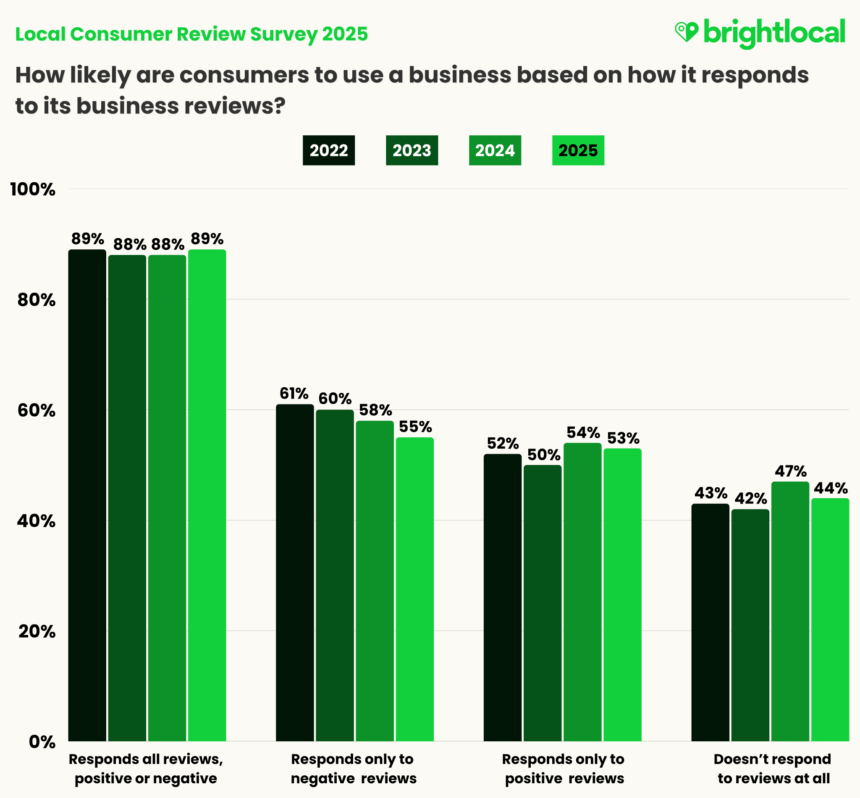
The five steps of responding to reviews
Responding to reviews, both positive and negative, needs to be done in a timely manner to be effective and impactful.
1. Use a tool
If you have a reputation management tool, you may be able to respond to the review directly from the dashboard. Use this if you have one available to you—it streamlines the process and makes it easier to keep track of which reviews you’ve responded to.
Curious about how BrightLocal can help? Skip to the end of this article for a walkthrough on Reputation Manager.
2. Be proactive
If you don’t have a reputation management tool, build manual response management into your daily schedule. Set time aside each day after you monitor online reviews to respond to new comments. It’s advisable to respond to negative reviews first (even ones you suspect to be fake) in order to limit the damage and put the wheels in motion for dispute resolution.
3. Shape an appropriate response
Reviewers generally fall into a specific category. Identifying which type of reviewer you’re dealing with will help you formulate a plan of action for your response. You can use our ‘Types of Reviewer’ resource to help you do this.
4. Take negative reviews off-site
Negative reviews are a fact of life for any local business. The key to dealing with them is having a honed response process. As a first step, encourage the reviewer to converse with you off the review site. Invite them to send you an email or to give you a call.
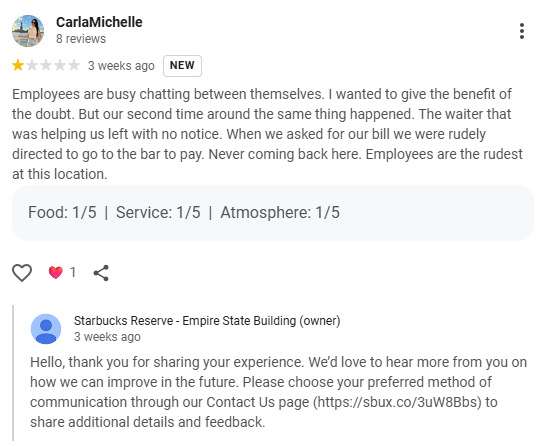
Once the issue is resolved, ask them to amend or update their review to reflect the steps taken to remedy the situation.
5. Develop a range of canned responses
If you don’t have time to craft a unique response for every review, develop a stock of templated responses that you can mix and match. Be sure to vary elements to suit the original review, such as referencing a staff member they’ve mentioned, a location (if you have multiple locations), or a particular product, service, or business feature (such as outdoor dining).
Our handy review response templates—with examples you can copy and paste—are a great starting point if you need help responding to positive reviews.
Responding to reviews Q&A
Does responding to reviews help SEO?
Responding to reviews is a local SEO ranking factor, with timeliness of response and responding to positive and negative reviews both playing a role. Google has confirmed that managing and responding to reviews does impact local search visibility.
Many businesses are so focused on generating reviews that they forget to reply to the reviewer. Responding is an easy way to add an additional layer of satisfaction to your customer service. It can also make a person more likely to use your business after they find you in the search results.
How to respond to a negative review?
When responding to negative reviews, approach with empathy and a genuine desire to resolve the issue. Calmly acknowledge the reviewer’s experience, apologize sincerely if warranted, and invite them to discuss the matter offline.
Keep your response professional, personalize your reply, and focus on solutions rather than blame. Thank the reviewer for the feedback; it shows you value every customer voice.
How you respond to negative reviews can help show potential customers that you are willing to listen and improve. While negative feedback can be hurtful, reframe the negative review as an opportunity to improve your service.
For a comprehensive guide on crafting effective responses, explore our full article on responding to negative reviews.
How do you respond to a 5-star review?
Replying to a five-star review is no different than replying to other positive reviews or those with three or four stars. Be timely in your response, thank the reviewer for sharing their experience, and be sure to modify your response to reflect a particular detail, such as a team member or feature that the reviewer enjoyed. Your response doesn’t need to be long or over the top. Simply be authentic, appreciative, and concise.

Related: Free Online Video Course – ‘A Beginner’s Guide to Generating and Managing Reviews‘
How do you thank someone for a positive review?
Responding to a positive review can be both quick and easy. Begin by thanking the reviewer for their feedback. Personalize your response by referencing something the reviewer particularly appreciated about your product or service, and invite them to take an action, such as visiting you again soon. Keep your response short, be genuine, and respond in as timely a manner as possible.
How do you respond to Google reviews?
Google is the most used online review platform, with 83% of consumers turning to it to find business reviews. To respond to Google reviews:
- Sign in to your Google Business Profile and go to ‘Read reviews’.

2. Click ‘Reply’ on the review you want to address.

3. Write a personalized and professional response.
4. Post your reply.
Stay on top of responding to your Google reviews by responding quickly, as these can have a big impact on how potential customers see your business.
How to respond to reviews with BrightLocal
Responding to reviews couldn’t be simpler than with BrightLocal’s all-in-one review management solution. Monitor feedback from all the top review sites, as well as the best review sites for your niche.
BrightLocal makes it easy to respond to reviews by bringing together reviews from 80+ general and niche review sites into one handy dashboard. Here’s how to respond quickly using BrightLocal:
- Connect your review profiles to your BrightLocal account to start monitoring your reputation.

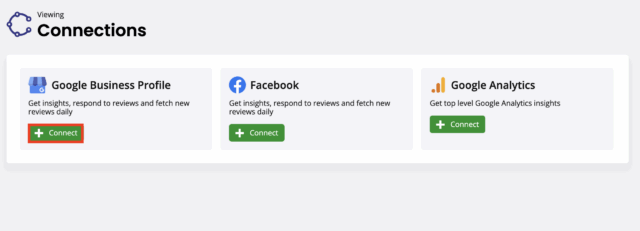
2. Set up email alerts so you’re notified quickly when new reviews come in.
3. In your account, head to Reputation → Manage Reviews.
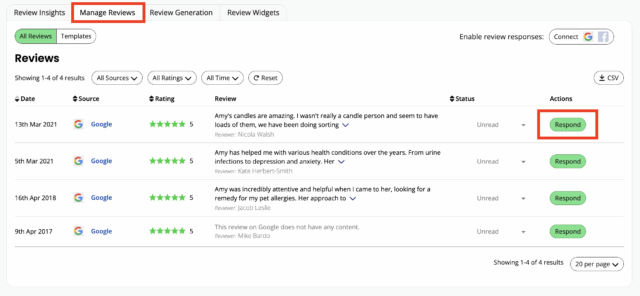
4. Click Respond on the Google or Facebook review, or click View to reply directly on other platforms.
5. Write your reply, or save time by choosing one of your saved review templates, or generating an AI-assisted response.
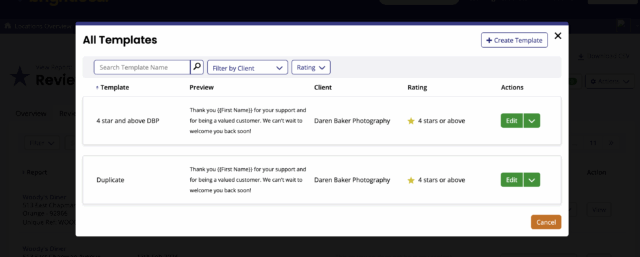
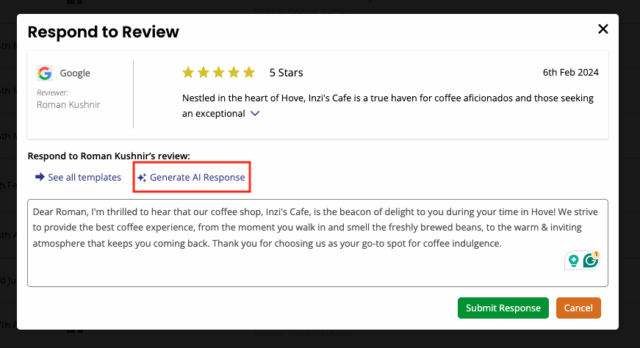
6. Submit the response, and ta-da! It will appear on the review shortly. For more detailed instructions, visit our Help Center.
Whether it’s five stars or one star, responding to online reviews is a simple but powerful way to show customers you care. With the right tools and processes in place, it’s easy to stay on top of feedback, protect your reputation, and show potential customers you’re always listening.